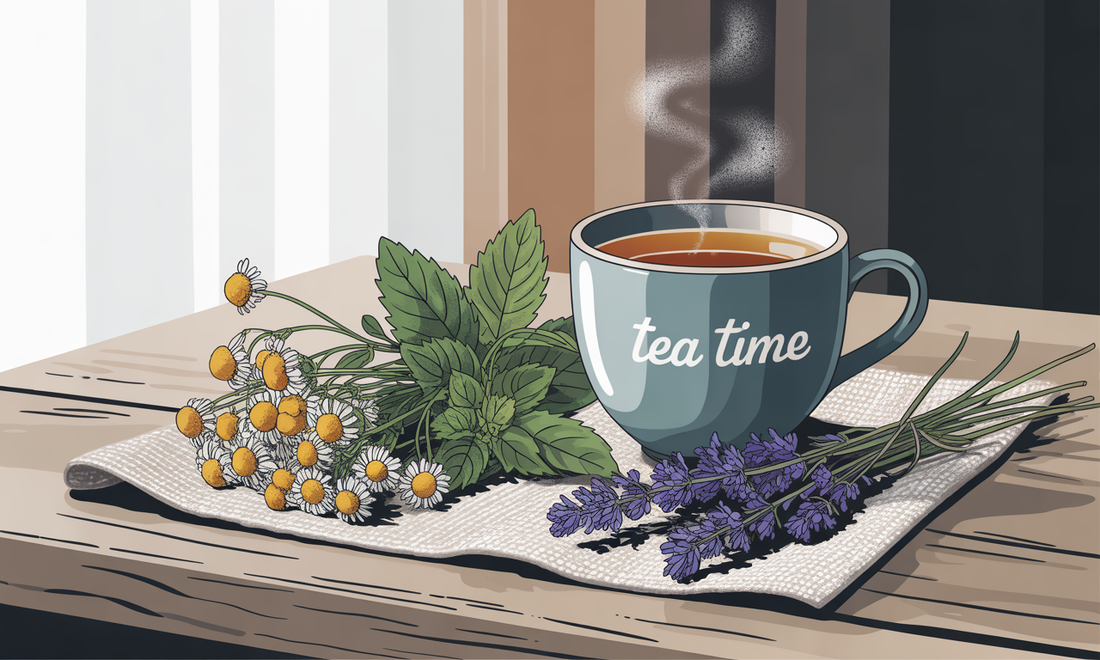In our fast-paced, high-pressure world, finding effective strategies for managing stress has become essential for maintaining wellbeing. This article explores how nervine herbs—nature's nervous system allies— can be incorporated into daily routines to promote calm, reduce anxiety, and build resilience against stress. From understanding what nervines are and how they work to practical guidance on their safe use, this comprehensive guide will help you discover gentle yet powerful botanical support for your nervous system.
The Daily Use of Nervines for Stress Relief

Understanding Nervines: Nature's Nervous System Allies
Nervines represent a special classification of herbs that specifically support and nourish the central nervous system. Unlike pharmaceutical interventions that often provide immediate sedation but may come with unwanted side effects, nervines work more subtly, gradually restoring balance to an overtaxed nervous system. These gentle botanical allies help rebuild nervous system health over time, making them ideal for daily use in our stress-filled modern lives.
The term "nervine" encompasses several sub-categories based on their specific actions. Nervine tonics strengthen and nourish the nervous system, nervine relaxants calm and soothe anxiety, while nervine stimulants gently energise without causing jitters. This versatility allows nervines to address various manifestations of stress, from anxious thoughts to physical tension and exhaustion.
It's important to distinguish nervines from adaptogens, another class of beneficial herbs. While adaptogens primarily work on the endocrine system to regulate hormonal stress responses and support adrenal function, nervines act more directly on the nervous system itself. Many herbalists recommend both classes of herbs in complementary protocols, as they address different aspects of the body's stress response mechanisms.

How Nervines Help Manage Stress
The human nervous system operates in two primary modes: the sympathetic ("fight-or-flight") and parasympathetic ("rest-and-digest") states. Modern life often keeps us locked in sympathetic dominance, with stress hormones continuously circulating through our systems. Nervines excel at promoting a shift toward parasympathetic activation, allowing the body and mind to enter a state of relaxation and recovery.

The beauty of nervines lies in their spectrum of effects. Some, like chamomile, offer gentle calming perfect for daily tension. Others, like valerian, provide stronger relaxation for acute stress or sleep difficulties. Unlike many pharmaceutical options, nervines rarely cause dependence or tolerance with regular use, making them suitable for ongoing stress management.
Research suggests that many nervines work through multiple pathways simultaneously. For instance, some affect voltage-dependent calcium channels, whilst others modulate neurotransmitter activity or influence the hypothalamic-pituitary-adrenal (HPA) axis. This multi-faceted approach helps explain why nervines can address various aspects of stress—from anxious thoughts to physical manifestations like tension headaches or digestive distress.
Five Key Nervine Herbs and Their Benefits


Each of these herbs has a long history of traditional use across various healing systems, from European folk medicine to Traditional Chinese Medicine and Ayurveda. While their mechanisms of action continue to be studied, both traditional knowledge and emerging research support their efficacy for nervous system support.
Forms and Methods of Daily Nervine Use
Nervines are remarkably versatile in their preparation methods, offering options to suit different lifestyles, preferences, and specific health needs. Understanding these various forms helps you select the most appropriate method for incorporating these herbs into your daily routine.
Herbal Teas (Infusions and Decoctions)
Perhaps the most accessible form of nervines, herbal teas offer both therapeutic benefits and the soothing ritual of preparation. For delicate parts like flowers and leaves (chamomile, lemon balm), steep in hot water for 5-10 minutes. For tougher parts like roots and bark (valerian), simmer gently for 15-20 minutes to extract medicinal compounds. A typical dose is 1-3 cups daily, with many people enjoying a cup before bed to promote restful sleep.
Tinctures and Extracts
These concentrated liquid preparations extract the medicinal compounds of herbs using alcohol, glycerin, or vinegar. Tinctures offer several advantages: precise dosing, longer shelf life, rapid absorption, and convenience. Typical dosages range from 20-60 drops (1-3 ml) taken 1-3 times daily, often diluted in water. Tinctures are particularly useful when stronger or quicker action is needed.

Capsules and Tablets
For those who dislike the taste of herbs or need maximum convenience, dried herb powders in capsules or compressed tablets offer a solution. They bypass taste considerations and are easy to incorporate into existing supplement routines. However, they lack the sensory experience that can itself be calming, and absorption may be slower compared to liquid preparations.
Other Preparations
Nervines can also be enjoyed as infused honeys, syrups, or even incorporated into foods like cookies or smoothies. Topical applications such as infused oils or bath herbs can complement internal use, especially for stress that manifests as muscle tension or skin issues.
"The ritual of preparing herbal tea can itself be therapeutic—the fragrance of the herbs, the warmth of the cup in your hands, and the few moments of quiet whilst sipping create a mindful pause in a busy day."
Safety and Interactions: What to Know Before You Start
While nervines are generally gentle and safe for most people, they are still pharmacologically active substances that deserve respect and careful use. Understanding potential safety concerns and interactions is essential before incorporating them into your wellness routine.


Quality and sourcing also impact safety. Choose products from reputable companies that grow their herbs organically, or test for contaminants and accurately identify plant species. Misidentification of plants can lead to unexpected adverse effects or lack of therapeutic benefit.
Integrating Nervines with Lifestyle for Optimal Stress Relief
Nervines offer powerful support for stress management, but their benefits are significantly amplified when integrated into a holistic approach to wellbeing. Rather than viewing these herbs as a standalone solution, consider them valuable tools within a broader stress-management strategy that addresses multiple aspects of health.

Many herbalists recommend combining nervines with adaptogens for comprehensive stress support. Whilst nervines directly soothe the nervous system, adaptogens like ashwagandha, rhodiola, or holy basil help regulate the body's stress response at the hormonal level. This combination addresses both immediate symptoms of stress and builds resilience against future stressors.
Consistency is key when working with nervines. These herbs generally work best through regular, ongoing use rather than as occasional interventions. Many people notice subtle improvements within days, but the most profound benefits often emerge after weeks or months of consistent use as the nervous system gradually rebalances.
Consider rotating between different nervines rather than using the same one continuously. This approach helps prevent potential habituation and allows you to experience the slightly different benefits each herb offers. For example, you might use milky oats tincture for a month to rebuild nervous system resources, then transition to skullcap to address tension patterns that have developed during periods of stress.
Current Research and Limitations
Whilst nervines have centuries of traditional use supporting their efficacy, scientific research on these herbs presents a more complex picture. Understanding both the existing evidence and the limitations of current research helps form realistic expectations about nervine benefits.

The evidence base for nervines reflects a common pattern in herbal medicine research: traditional use and practitioner experience far outpace formal scientific validation. This doesn't necessarily mean nervines are ineffective, but rather that our scientific understanding of their mechanisms and optimal applications remains incomplete.
The complexity of herbal medicine poses unique challenges for research. Unlike isolated pharmaceutical compounds, herbs contain hundreds of potentially active constituents that may work together synergistically. Traditional herbal practice also emphasises individualised treatment approaches rather than standardised protocols, making controlled studies more difficult to design.
Additionally, subjective experiences like stress, anxiety, and sleep quality—the primary targets of nervine herbs—can be difficult to measure consistently across study participants. Self-reporting tools are commonly used but have inherent limitations in capturing the full spectrum of nervine effects.
Despite these challenges, research interest in nervine herbs is growing as stress-related conditions become increasingly prevalent in modern society. Emerging research technologies like metabolomics and systems biology may offer new approaches to understanding these complex botanical medicines more comprehensively.
Conclusion: Embracing Nervines for Daily Stress Resilience
In our high-speed, high-pressure world, the gentle yet profound support of nervine herbs offers a valuable counterbalance to daily stressors. These botanical allies work not through quick fixes or symptom suppression, but by gradually restoring the nervous system's innate capacity for resilience and equilibrium. As we've explored throughout this document, nervines represent a holistic approach to stress management that addresses both immediate symptoms and long-term nervous system health.
The beauty of nervines lies in their accessibility and integration into daily life. Whether enjoyed as a morning cup of lemon balm tea, a midday skullcap tincture during a stressful workday, or an evening ritual with chamomile before bed, these herbs can be seamlessly woven into existing routines. Their subtle yet cumulative effects build over time, creating a foundation of nervous system support that enhances overall wellbeing.
It's worth emphasising that nervines work best as part of a comprehensive approach to stress management. When combined with appropriate lifestyle measures—adequate sleep, regular movement, mindfulness practices, and healthy social connections—nervines amplify the body's natural capacity for stress recovery. This integrative approach acknowledges that true resilience comes not from a single intervention but from supporting the body's innate balance through multiple complementary pathways.

As you consider incorporating nervines into your wellness routine, remember that herbalism is both science and art. While research provides important guidance, your personal experience with these herbs—how they make you feel, how they affect your stress patterns, how they integrate with your unique physiology—is equally valuable information. Working with a qualified herbalist can help you navigate this journey with personalised support, particularly if you have existing health conditions or take medications.
In a culture that often glorifies busyness and pushing through stress, nervines offer a gentle reminder of a different way—one that honours the body's need for rest, recovery, and nervous system nourishment. By embracing these botanical allies as part of daily self-care, we can cultivate not just temporary calm, but lasting nervous system resilience in the face of life's inevitable challenges.
